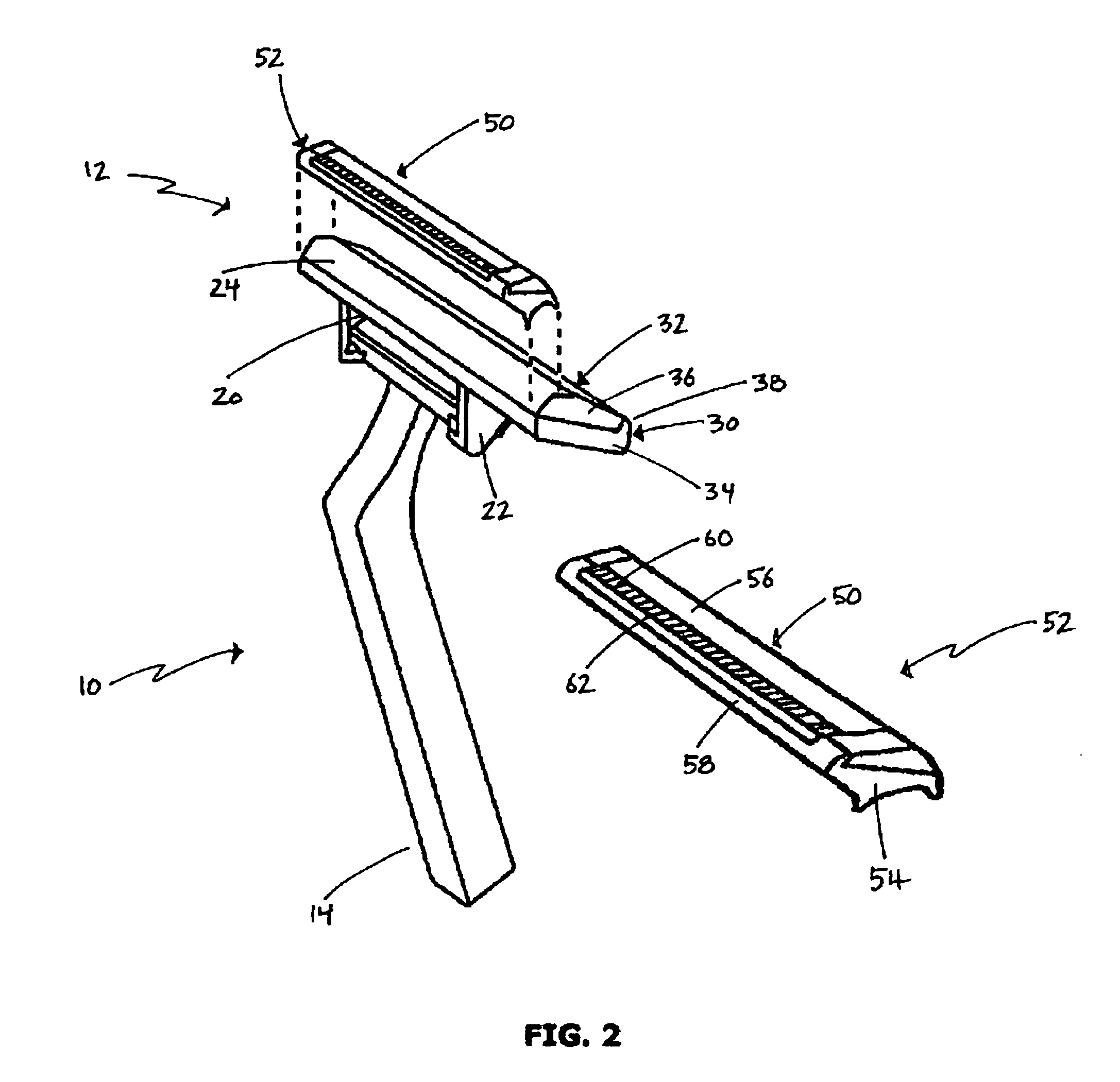Current shaving razor designs do not provide individuals the multiple benefits of a convenient, simple and effective means of shaving both the broad / open areas of the body as well as the confined / hard-to-reach areas of the body with the same shaving device.
A first blade edge is used until dull, filled with lather or
cut hairs, becomes damaged, i.e., the first blade edge is no longer efficient and / or safe to continue
cutting hair.
However, each of the first and second blade edges dulled easily as single blades and therefore sometimes did not deliver a close, smooth and comfortable shave.
The razor blades in such replaceable cartridges dull fairly rapidly with use and thus they are frequently replaced, typically after just a dozen or fewer shaves.
However, there are unexpected deficiencies with modern conventional blade designs.
While this design in general offers the individual a closer and more comfortable shave for shaving broad areas of the face, it also necessarily creates a deficiency and
usability shortcoming by limiting the individual's ability to use the shaver to reach into confined, hard-to-reach and delicate areas of the face and body such as under the nostrils, in
chin clefts, around mustaches and on sideburn and beard edges and the like with precision and accuracy.
This difficult maneuvering process of the razor is cumbersome for many individuals and often results in an inability to
cut the targeted hair.
Additionally, in the case where the individual is overly persistent in attempting to position the razor into these confined areas,
skin irritations and sometimes
skin abrasions or lacerations may be produced.
Thus, it may be said, that the new generation of multiple-blade razors comprising two, three or more parallel in-line blades and comfort / lubricating strips provide superior shaving closeness and comfort in broad open areas but make shaving confined, hard-to-reach areas difficult and cumbersome.
Further, earlier generations of single blade razor systems provide the benefits of precision trimming and sculpting control in confined, hard-to-reach areas but do not optimize broad-area shaving comfort and closeness.
There have been previous attempts at trimming and sculpting razors, but none has overcome deficiencies set forth above.
Limited efforts have been made to address this shortcoming.
While several types of razor designs that can shave both broad / open and relatively flat areas as well as confined, hard-to-reach areas with the same device have been proposed, none of the proposed designs offer an optimal solution that is at the same time affordable, convenient, easy-to-use and provides an individual-experience consistent with the shaving razor systems that are presently commercially available and in public use.
In this design, there are two separate razor heads, which means the structure is bulky and has limited maneuverability.
Further, using two razor heads add significantly to the cost of the razor approach by requiring two
cartridge support structures and two cartridges.
More significantly, the complex mechanical
handle structure having movable parts and a telescoping member adds greatly to the manufacturing cost of the approach.
So, as with the Branchinelli design, there are two separate razor heads, which means the structure is bulky and has limited maneuverability.
Further, using two heads adds significantly to the cost of the razor approach by requiring two cartridge support structures and two cartridges.
While the approach presented embodies a single-head razor approach, the four-sided blade in the Rocha design would add significantly to the cost of manufacturing the blade cartridge.
Further, the complex nature and multi-function use of the razor
handle containing a water-flushing system and reservoir and
plunger for loading and dispensing oils, creams and other liquids make the system cumbersome to use and costly to produce.
While the approach presented embodies a single-head razor approach, the angled blade configuration in the Savage design would add significantly to the cost of manufacturing the blade cartridge.
Further, only one of the blades on the razor head is used for broad-
stroke shaving and therefore does not offer the individual the optimal and effective means for shaving broad areas of the face afforded by a razor with a plurality of blades on a common plane specifically designed for that purpose.
The Diakonov design is primarily used for trimming beards and mustaches and does not offer the individual an optimal and effective means for shaving broad areas of the face.
Further, the complex nature and multi-function use of the razor handle containing a retractable system and multiple razor heads makes the system complicated to use and costly to produce.
While the Ledesma design offers the individual some improved ability to shave restricted areas, it does not optimize the razor's ability to effectively, rapidly and efficiently shave the broad, open
skin surfaces of the face.
Thus, improvements in dual-purpose shaving and trimming / sculpting razors are still needed as the prior art has not properly solved the deficiencies of effectively and economically shaving both broad / open and relatively flat areas in addition to confined, hard-to-reach areas with the same device.
 Login to View More
Login to View More 


